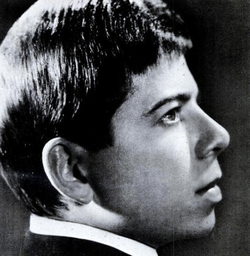Bobby Goldsboro
| Bobby Goldsboro | |
|---|---|
|
Bobby Goldsboro in 1967 | |
| Background information | |
| Born |
January 18, 1941 Marianna, Florida, United States[1] |
| Genres | Country, Adult Contemporary, Pop |
| Occupation(s) | Singer-songwriter, guitarist, painter, television producer |
| Instruments | Vocals, guitar |
| Years active | 1962–present[1] |
| Labels | United Artists, Curb[1] |
| Website | www.bobbygoldsboro.com |
Bobby Goldsboro (born January 18, 1941)[2] is an American pop and country singer-songwriter. He had a string of pop and country hits in the 1960s and 1970s, including his signature No. 1 hit "Honey", which sold over one million copies in the United States.
Biography
Early life
Goldsboro was born in Marianna, Florida.[2] During his first year of life, his family moved 35 miles north from Marianna to Dothan, Alabama.[1] He graduated from Dothan High School in 1959 and later enrolled at Auburn University. Goldsboro left college after his second year to pursue a musical career. He played guitar for Roy Orbison from 1962 to 1964.
Career
Goldsboro's solo career picked up steam with the top ten hit "See the Funny Little Clown". The single, written by Goldsboro, reached No. 9 on the U.S. national charts in early 1964. It sold over one million copies and was awarded a gold disc.[2] It was to be the first of a string of similar awards. Goldsboro would go on to have 16 Top 40 hits on the Billboard Hot 100 and 12 on the country chart.[1][3] In 1966 he recorded "It's Too Late" with "Too Many People" on the B-side. Although Goldsboro was not a prolific performer of dance music, both of these songs were huge hits on the Northern soul scene in Great Britain and were played extensively.[4] His biggest hit was 1968's "Honey", a tearjerker about the death of a man's lover.[1][3] The song, written by Bobby Russell, was recorded in one take.[5] It became the largest-selling record in the world for 1968 and topped the Hot 100 for five weeks, reached number two in the UK Singles Chart on two separate occasions (1968 and 1975),[6] and was a number one single in Australia.[2] It also became his first country hit.
One of Goldsboro's compositions, "With Pen in Hand", was recorded by several artists, including a Grammy-nominated pop version by Vikki Carr that reached the Hot 100's top 40 in 1969; Johnny Darrell had taken the song to No. 3 on the US country chart a year earlier.[7] In 1970 Della Reese included a cover on her album Black Is Beautiful. Goldsboro's "The Cowboy and the Lady" became a "Top 10" country hit as "The Cowgirl and the Dandy" for Brenda Lee in 1980; Dolly Parton had also covered it in 1977, and John Denver had a hit with the song in 1981.
"Summer (The First Time)", a 1973 reminiscence about a 17-year-old boy's first sexual experience with a 31-year-old woman, was a Top 25 hit in the U.S. and reached number 9 in the UK.[8] It was voted the all-time greatest "summer" song in England's history. Using a repeating piano riff, 12-string guitar, and an orchestral string arrangement, the song was suggestive enough to spark some controversy. A follow-up, "Hello Summertime", was written by Roger Cook and Roger Greenaway and hit No. 14 in the UK in late 1974.[6][8]
From 1973 to 1975, Goldsboro hosted the successful syndicated television variety series The Bobby Goldsboro Show. In the 1990s, he composed the music for the CBS situation comedy Evening Shade. In 1995, he created the fifty-two episode children's television series The Swamp Critters of Lost Lagoon. Goldsboro voiced all the characters, wrote all the scripts, and played all the musical instruments.[9] Goldsboro is also an accomplished oil painter.[10]
Discography
- Honey (1968)
- Word Pictures (1968)
References
- 1 2 3 4 5 6 Whitburn, Joel (1996). The Billboard Book of Top 40 Country Hits, p.128-129. ISBN 0-8230-7632-6.
- 1 2 3 4 Murrells, Joseph (1978). The Book of Golden Discs (2nd ed.). London: Barrie and Jenkins Ltd. pp. 175, 191, 205, 240 & 279. ISBN 0-214-20512-6.
- 1 2 Whitburn, Joel (2000). The Billboard Book of Top 40 Hits, p.267. ISBN 0-8230-7690-3.
- ↑ "Bobby Goldsboro – Too Many People". www.discogs.com. Retrieved June 14, 2011.
- ↑ Roland, Tom (1991). The Billboard Book of Number One Country Hits, p.9. ISBN 0-8230-7553-2.
- 1 2 British Hit Singles & Albums (19th ed.). London: Guinness World Records Limited. p. 230. ISBN 1-904994-10-5.
- ↑ "Hot Country Singles", Billboard, July 6, 1968. p. 36
- 1 2 "Bobby Goldsboro". www.officialscharts.com. Retrieved 19 November 2013.
- ↑ "Bobby Goldsboro Biography". AllMusic. Retrieved 28 December 2013.
- ↑ "The Art of Bobby Goldsboro". bobbygoldsboro.com.
Bibliography
- Allmusic
- Wood, Gerry (1998). "Bobby Goldsboro". In The Encyclopedia of Country Music. Paul Kingsbury, Editor. New York: Oxford University Press. p. 205.
External links
- Official website
- Bobby Goldsboro at the Internet Movie Database
- Bobby Goldsboro discography at Discogs
- Bobby's recent radio interview show with Ronnie Allen
